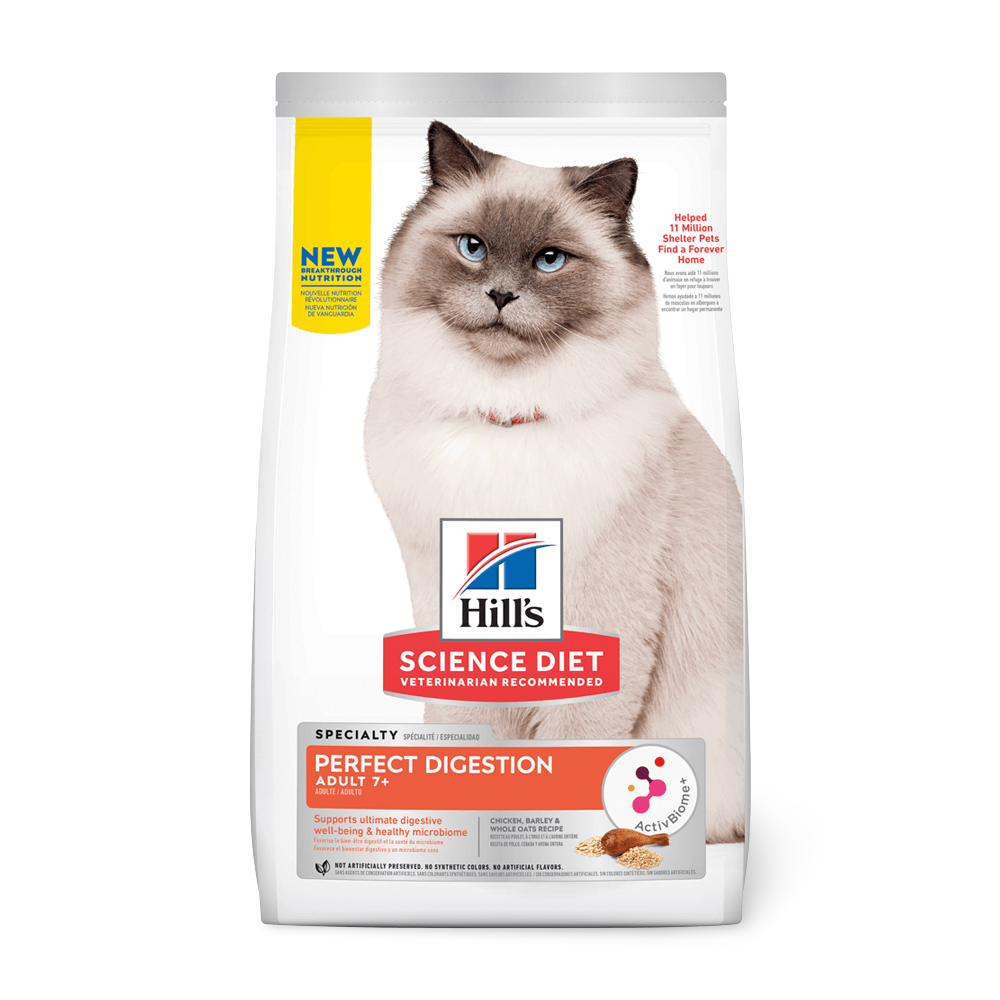What You Need To Know About Your Cat's Digestive System
This article is written by Pet Circle veterinarian, , in partnership with .
The cat's digestive tract is a complex system designed to extract and absorb nutrients from food to help fuel their many body functions. Understanding your cat's digestive system can help you to know how to support their health and well-being.
In this article we will explore the feline digestive system and how to keep it healthy, starting with pet parent's most frequently asked questions about a cat's digestive system.
Shop All Hill's Science Diet Products
Contents:
- Top Questions about your Cat's Digestive System
- Maintaining Your Cat's Digestive System Health
- How a Cat Digestive System Works
Top Questions about your Cat's Digestive System
Is wet or dry cat food better for a cat's digestion?
A combination of both wet and dry food is generally recommended for most cats, although this can vary depending on the owner and cat's preferences, as well as with some health conditions.
Wet food has a moisture content and is approximately 80% water, compared to dry food which is usually closer to 10%. Because of this, wet food is a good way to help boost water intake, but remember to always keep fresh water available as well.
It is recommended to look for premium dry cat food, such as Hill's Science Diet, which is made with high quality, easy -to-digest ingredients for optimal nutrient absorption.
How long does it take for a cat to digest its food?
It can take between 10 and 24 hours for a cat to completely digest its food from mouth to tail. The type and amount of food eaten, as well as the cat's water intake can all affect the rate of digestion.
Why do some cats vomit after eating?
Vomiting after eating in cats can be caused by a variety of factors. These include eating a large amount of food too quickly, hairballs, food intolerances or other digestive system disorders.
It's important to identify the underlying cause behind the vomiting to provide appropriate treatment. It could be as easy as switching to a sensitive stomach cat food diet, like Hill's Science Diet Adult Sensitive Stomach And Skin Dry Cat Food or Hill's Science Diet Feline Perfect Digestion but it is best to speak with your vet. If your cat is repeatedly vomiting after eating or is showing other signs of being unwell such as diarrhoea, loss of appetite or lethargy, it is recommended to seek immediate veterinary attention.
Want to learn more? Read our article on Vomiting and Regurgitation in Cats.
Can hairballs cause digestive issues in cats?
Hairballs are a common cause of digestive problems in cats. Cats will naturally ingest some hair during their grooming process. This hair can accumulate over time and form a hairball in the stomach or intestines, resulting in symptoms like vomiting and constipation.
Grooming your cat to remove loose hairs from the coat can help reduce the amount of hair ingested. Feeding a hairball control diet, like Hill's Science Diet Feline Adult Hairball Control, can also help to move hair through the digestive tract to help avoid hairballs forming.
Want to learn more? Read our article on Hairballs in Cats.
Maintaining Your Cat's Digestive System Health

Problems with the digestive system can cause a variety of symptoms in cats including vomiting, regurgitation, diarrhoea and constipation. Common digestive health issues in cats include:
- Intestinal parasites
- Hairballs
- Inflammatory Bowel Disease
- Constipation caused by dehydration, pain or motility problems in the large intestine
There are a few things you can do to help keep your cat's digestive system healthy including keeping up to date with parasite control, and increasing your cat's water intake.
Supporting a healthy balance of bacteria in the gut has also been proven to help with digestive health. By feeding a diet enhanced with prebiotics including different types of fibre, you can encourage the growth of beneficial bacteria. Hill's Science Diet Feline Perfect Digestion contains Hill's exclusive blend of prebiotics, ActivBiome+, to support each pet's unique microbiome for healthy digestion and overall well-being.
Dietary fibre can also assist with hairballs by helping to move hair ingested during grooming through the digestive system.
Within the Hill's Science Diet range, there are perfectly balanced diets for kittens, adults and senior cats. All Hillâs Science Diet dry foods contain clinically proven antioxidants, Vitamins C & E, for a healthy immune system.
There are also diets for specific needs including:
- hairball control and urinary health
- sensitive stomachs and skin
- plaque and tartar build up
- weight management
How a Cat Digestive System Works
As true carnivores, cats have a relatively short and simple digestive tract designed primarily to digest and absorb nutrients from animal based nutrients.
This differs from that of the dog who as an omnivore has a longer small intestine to facilitate digestion and absorption of nutrients from both animal and plant based foods.

Food Digestion Starts At The Mouth
Cats have sharp, pointed teeth designed to grasp, tear and slice through their food. Once the food enters the mouth it is broken into smaller pieces by the back teeth and mixed with saliva before being swallowed with the assistance of the tongue.
It is not uncommon for cats to swallow dry food whole, as their digestive tract is designed to accommodate larger chunks of food.
Pushing Food Down The Oesophagus
After swallowing, food travels down the oesophagus, a muscular tube that leads to the stomach. The muscle fibres lining the oesophagus contract in a wave like motion known as peristalsis pushing the food down to the lower oesophageal sphincter, which relaxes to allow entry to the stomach.
Digestive Enzymes Break Down Food In The Stomach
In the stomach, the ingested food is mixed with gastric juice containing digestive enzymes, hydrochloric acid and mucous.
The primary digestive enzyme secreted in the stomach of the cat is pepsin, which is responsible for breaking down proteins.
Pepsin works best in an acidic environment, which is created by the hydrochloric acid. The mucous in the gastric juice helps to protect the cells of the stomach wall from the digestive enzymes and acidic environment.
Similar to the oesophagus, the stomach contracts in peristaltic waves to help mix the gastric juice and food thoroughly.
The end result of this process is a thick milky liquid called chyme, which passes through the pyloric sphincter of the stomach into the first part of the small intestine, the duodenum.
The Duodenum Breaks Down Food Further
In the duodenum, more digestive enzymes are secreted from the intestinal wall and the pancreas to facilitate digestion of proteins, carbohydrates and fats.
Although they are carnivores, cats do secrete amylase from the pancreas and are able to digest carbohydrates and absorb their breakdown products into the blood as a source of energy.
The small intestine is where most of the nutrients are absorbed from the food. For proteins and carbohydrates, this occurs through specialised cells in the intestinal walls known as enterocytes.
Along with the enzymes released from the intestinal wall and pancreas, bile is also released from the gallbladder to help break down fats into smaller globules, ready to be absorbed into the lymphatic system before reaching the bloodstream.
Large Intestine Begins Absorbing Water
After the small intestine, the remaining undigested food reaches the large intestine, where predominantly water is absorbed.
In the large intestine, there is also some fermentation of carbohydrates and dietary fibre by beneficial bacteria. The process of fermentation produces short chain fatty acids which can be absorbed and used as a source of energy for the body.
Undigested Food Evacuated Through The Rectum
By the end of the large intestine, the faecal matter is formed, which is composed of undigested food, water and waste products produced by the body including dead cells, mucous and bacteria. The faeces then enter the rectum where they are stored before being evacuated through the external anal sphincter in the litter tray.
The digestive system is an essential part of your cat's health and well-being, providing their body with the nutrients needed to function. There are a variety of factors that can have an effect on the process, including parasites, diet, water intake and other health conditions. One simple thing you can do everyday to help maintain your cat's healthy digestion is to feed a high quality diet, particularly one designed to support optimal digestion.
Further Reading
Want to read more? Check out our other articles including:
Raw pet food: The benefits and risks
Premium pet food: Is it worth it?
Want to know more? Check out our Discover Page for more tips on keeping your pets happy and healthy.



























